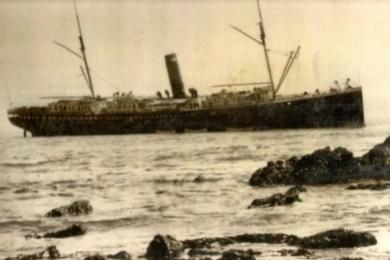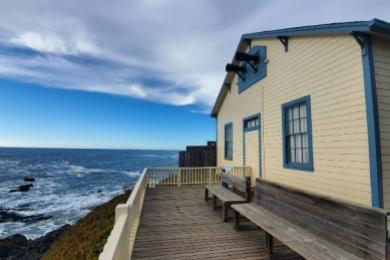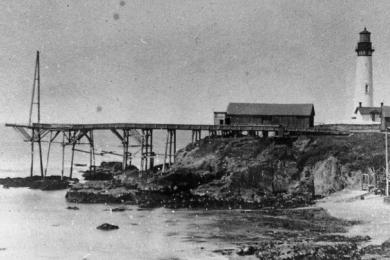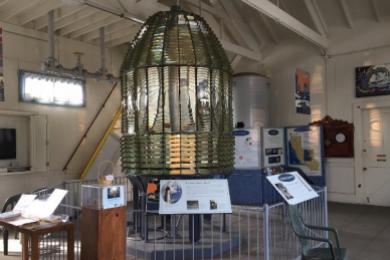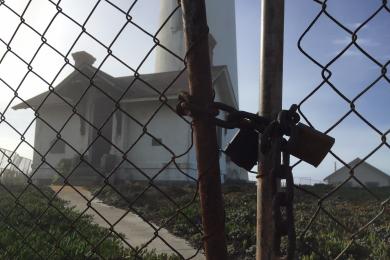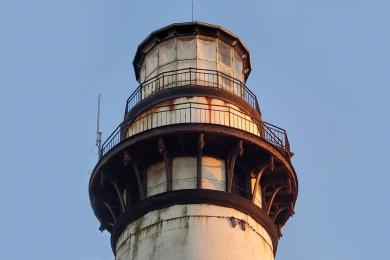Is Pigeon Point the tallest lighthouse on the US West Coast?
Pigeon Point Lighthouse is tied for the tallest on the west coast? Standing at 115 feet tall, Pigeon Point Lighthouse and the Point Arena Lighthouse are the tallest lighthouses on our side of the US - and they're both in California!
Why is there a lighthouse here?
After the wreck of the Clipper Ship Carrier Pigeon in 1853, the federal government knew another lighthouse was needed on this particular stretch of coast. Due to difficulties in acquiring property, and debates on whether a lighthouse should be built at Pigeon Point or Point Año Nuevo, years passed by without any progress. In the meantime, two more ships wrecked at Pigeon Point. In fact, it took a total of 15 years and massive public outcry after the wreck of a fourth ship, the Hellespont in 1868, that Congress finally approved funds for the Pigeon Point Lighthouse to be built.
How many bricks were used?
Construction on the light station began in 1871 and finished the following year.
As the only brick structure (and, let’s be honest, probably the most important one) in the original 1871 plans, the lighthouse tower caused more than a few delays during construction.
One such delay was caused by the bricks themselves. Over 500,000 of them were used to construct the lighthouse tower; they were kilned locally, most likely in nearby Pescadero. Unfortunately, the first batch of bricks weren’t quite up to snuff – shortly after construction on the tower began, a memorandum was sent out requiring that all of the bricks on-site be sent back to be rekilned, including any that had already been put to use building the tower.
That said, it was probably for the best as those same bricks have lasted.
Why is it called a light station?
A Light Station contains more than just a lighthouse, such as a fog signal that can be used when the light is obscured by weather.
The original Fog Signal Building was constructed towards the late half of 1871, but was replaced by the structure we have now in 1899. The first fog signal was steam-powered: wood was burned in a firebox, which then heated water in a boiler, creating steam that would move through a smokestack and eventually out through a whistle regulated by a timer. It’s often said that the original signal sounded like a “cow in distress”.
The mechanics of the fog signal changed three times over the years; first to a compressed air siren, then to a two-tone diaphone, and finally a diaphragm.
The fog signal was discontinued in 1976 at Pigeon Point due to advances in radar and hasn’t been sounded since. Earlier this year we finished restoring our historic Fog Signal Building. Check out the report of this project.
What was life like at Pigeon Point?
Over the years Pigeon Point has been home to all manner of side businesses, including a small shipping center, a wharf, a large warehouse, a whaling station, a community of whalers, and even an abalone farm.
During Prohibition, Pigeon Point was an optimal location for rumrunning. Its isolation, equipment allowing them to hoist liquor from the beach, and proximity to the highway (and major cities like San Francisco) made it very appealing for these bootleggers. In fact, one night an Assistant Keeper was forced at gunpoint to drive one of these rumrunners 8 miles down the coast!
Where was the lens made?
Pigeon Point's First Order Fresnel Lens, at 16 feet tall and 6 feet in diameter, was originally constructed in Paris, France. It shipped across the Atlantic in 72 separate crates and was stored in a warehouse on Staten Island before being installed as a replacement lens at the Cape Hatteras Lighthouse during the Civil War. After Cape Hatteras built their new Lighthouse, our lens was sent back to storage on Staten Island for 6 months before being shipped again, this time around Cape Horn. It was installed into the freshly completed tower in 1872.
Has there been earthquake damage over the years?
Over the past 148 years, Pigeon Point Lighthouse has survived two major earthquakes. The Great 1906 San Francisco earthquake left the tower completely unscathed, due to both the solid bedrock the tower is built upon and our distance from the fault line - despite how close we are to San Francisco. Even the 1989 Loma Prieta earthquake only left a minor crack in the upper levels of the tower that was quickly repaired.
Why is the tower locked off?
As many of you know, Pigeon Point Lighthouse has been closed to the public for quite some time. But do you know the reason why? In 2001 a large storm passed through the point. The lighthouse tower’s iron belt course, which had rusted over the years prior to this storm, swelled with water. It then cracked and fell, taking two separate 300-lbs chunks of brick with it. That iron belt course acts like a rubber band around a stack of pencils stood up on their erasers; now that the rubber band has snapped, the stack of pencils is liable to fall. A mesh band was added around the damaged belt course, and has been holding it together ever since. Luckily, no other pieces have fallen since then.
Some good news, though: in July 2019 the State Park received $9 million from the State of California to begin restoring the lighthouse tower.
What’s even better? We’re hopeful that the restoration process will start in 2021.

